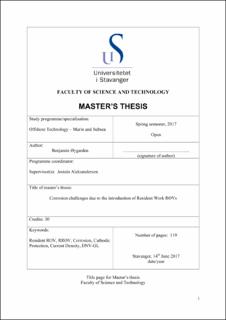| dc.description.abstract | The lasts development in remotely operated vehicles, ROV, have led to the introduction ofResident ROVs that is supposed to stay submersed for longer periods without the frequent maintenance. The increased time between planned maintenance introduces new challenges, and perhaps most important one, is corrosion challenges. Thisthesis is both a study of the corrosion challenges on IKM Subsea’s Merlin UCVresidentROV that is intended to be placed on the seabed below Snorre B, and a more general study of corrosion challenges relating to longer ROV operations.To protect against corrosion, the most commonmitigation measure is to usecoatings, cathodic protection and corrosive resistant metals/alloysby following standards. The perhaps most common standard for offshore steel and aluminium structures, is the DNV RP-B401 standard. This was developed to help companies install effective cathodic protection so that the protected structure was safe for several years. However, the standard is made on the assumption that the protected structure is submersed for a far longer period than a residentROV currently is intended to.The DNV standard have differentiated between the anode consumption in an initial phase, a mean phase, and a final phase. This is because the anode consumption is much larger in the beginning prior to polarization, while averaging at a lower mean value before it goes back up at the end of the anodes lifetime. It recommends that one uses the mean value to estimate the total anode consumption, while the initial and mean helps make sure the anodes are capable of higher short term consumption. In terms of corrosion resistive alloys and metals that is getting more and more popular due to lower prices and normally high reliability, challenges relating to especially galvanic and crevice corrosion is important to overcome or at least understand. In the industry one have for a long time used isolators to reduce the possibility of galvanic corrosion, but quite often endedup with crevice corrosion. This makes it important to understand the mechanisms behind.During this study, it has become apparent that metal combinations should be better understood. The lack of experience with more complex material combinations is perhaps because it usually works well for short term operations, while one avoid them at longer operations due to the risk of problems.Asaresult of an experiment performed during the writing of this thesis, and study of literature, all metal parts on a residentROVs should be under cathodic protection. One should dimension the anodes to be in the initial phase throughout its design life, and one should find anodes with a slightly higher potential to work better on more noble alloys and metals.Some of the challenges faced during this thesis was to find ways to predict the important and relevant corrosion processes that one needs to overcomefor the given material combination, material complexity and time frame. This is because some of the corrosion processes that are important for short time operation, might not be important over time and vice versa.Another problem has been to gather relevant information and to get help from experienced persons with relevant expertise. Most literature deals with long term corrosion challenges that is not always directly transferable, while most people in the industry have limited experience in ROV operations of more than a few weeks. | en_US |
